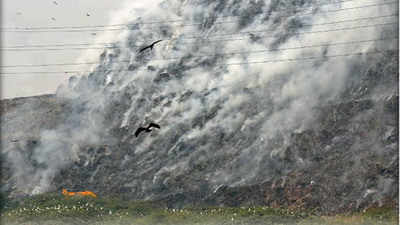- News
- City News
- delhi News
- Toxic cocktail of pollutants in air near Delhi's Ghazipur
Trending
This story is from November 26, 2020
Toxic cocktail of pollutants in air near Delhi's Ghazipur
While the capital is already reeling under “severe” air, those residing in the vicinity of the Ghazipur landfill site got a double blow with the waste mound going up in flames on Tuesday night. Not only was the smoke visible several kilometres away, but those near the landfill could feel their eyes burning and also having difficulty in breathing due to the toxic cocktail of pollutants in the air.

Not only was the smoke visible several kilometres away, but those near the landfill could feel their eyes burning
NEW DELHI: While the capital is already reeling under “severe” air, those residing in the vicinity of the Ghazipur landfill site got a double blow with the waste mound going up in flames on Tuesday night. Not only was the smoke visible several kilometres away, but those near the landfill could feel their eyes burning and also having difficulty in breathing due to the toxic cocktail of pollutants in the air.
Track the pollution level in your city
The two nearest ambient air quality monitoring stations of Central Pollution Control Board — Anand Vihar and Patparganj — showed an AQI above 400, which falls in the “severe” category.

Anumita Roy Chowdhury, executive director, research and advocacy, at Centre for Science and Environment, said landfill fires pose a greater risk than a regular blaze owing to the huge amounts of mixed garbage. “The waste there is toxic and such fires are often continuous in nature, lasting for hours. This can cause a huge amount of toxic emissions to be released in the surrounding areas, exposing people of the low-income group living in the neighbourhood extremely vulnerable in terms of health. The smoke can also worsen underlying health conditions,” she added.
DPCC data showed the average PM2.5 concentration at Anand Vihar touched 462 µg/ m3 at 4am, over seven times the safe standard, while the highest hourly PM2.5 concentration at Patparganj was 421 µg/m3. The standard for PM2.5 is 60 µg/m3.
Meteorological conditions are expected to play an important role over the next 48 hours. “The possibility of very light rain on Thursday will help settle pollutants in the area. Wind speed is also expected to be good, which may help in the dispersal of pollutants. If there is enough rain, pollutants will settle down. However, inadequate rain may only add more moisture to the polluted air,” said a Met official.
Delhi produces around 10,000MT of waste each day, a majority of which is dumped at the Bhalswa, Ghazipur and Okhla landfill sites. All three sites had exhausted their capacity long ago. The combustible methane gas produced at the sites often catches fire. Studies have shown that methane gas is toxic in the long run. The fumes generated add a toxic mix of carbon dioxide, carbon monoxide, hydrogen sulphide, carcinogenic dioxins and furans to the particulate matter in the air.
A landfill fire generally tends to raise the ambient PM 2.5 concentration in the area, owing to combustion, while secondary particulate formation and release of other gases also occur simultaneously.
Track the pollution level in your city
The two nearest ambient air quality monitoring stations of Central Pollution Control Board — Anand Vihar and Patparganj — showed an AQI above 400, which falls in the “severe” category.

Delhi Pollution Control Committee (DPCC) data also showed the average hourly PM2.5 concentration at over 400 micrograms per cubic metre (µg/m3) all through the night, when the fire raged on, which dropped below 300 µg/m3 only after noon on Wednesday.
Anumita Roy Chowdhury, executive director, research and advocacy, at Centre for Science and Environment, said landfill fires pose a greater risk than a regular blaze owing to the huge amounts of mixed garbage. “The waste there is toxic and such fires are often continuous in nature, lasting for hours. This can cause a huge amount of toxic emissions to be released in the surrounding areas, exposing people of the low-income group living in the neighbourhood extremely vulnerable in terms of health. The smoke can also worsen underlying health conditions,” she added.
DPCC data showed the average PM2.5 concentration at Anand Vihar touched 462 µg/ m3 at 4am, over seven times the safe standard, while the highest hourly PM2.5 concentration at Patparganj was 421 µg/m3. The standard for PM2.5 is 60 µg/m3.
Meteorological conditions are expected to play an important role over the next 48 hours. “The possibility of very light rain on Thursday will help settle pollutants in the area. Wind speed is also expected to be good, which may help in the dispersal of pollutants. If there is enough rain, pollutants will settle down. However, inadequate rain may only add more moisture to the polluted air,” said a Met official.
Delhi produces around 10,000MT of waste each day, a majority of which is dumped at the Bhalswa, Ghazipur and Okhla landfill sites. All three sites had exhausted their capacity long ago. The combustible methane gas produced at the sites often catches fire. Studies have shown that methane gas is toxic in the long run. The fumes generated add a toxic mix of carbon dioxide, carbon monoxide, hydrogen sulphide, carcinogenic dioxins and furans to the particulate matter in the air.
A landfill fire generally tends to raise the ambient PM 2.5 concentration in the area, owing to combustion, while secondary particulate formation and release of other gases also occur simultaneously.
End of Article
FOLLOW US ON SOCIAL MEDIA










